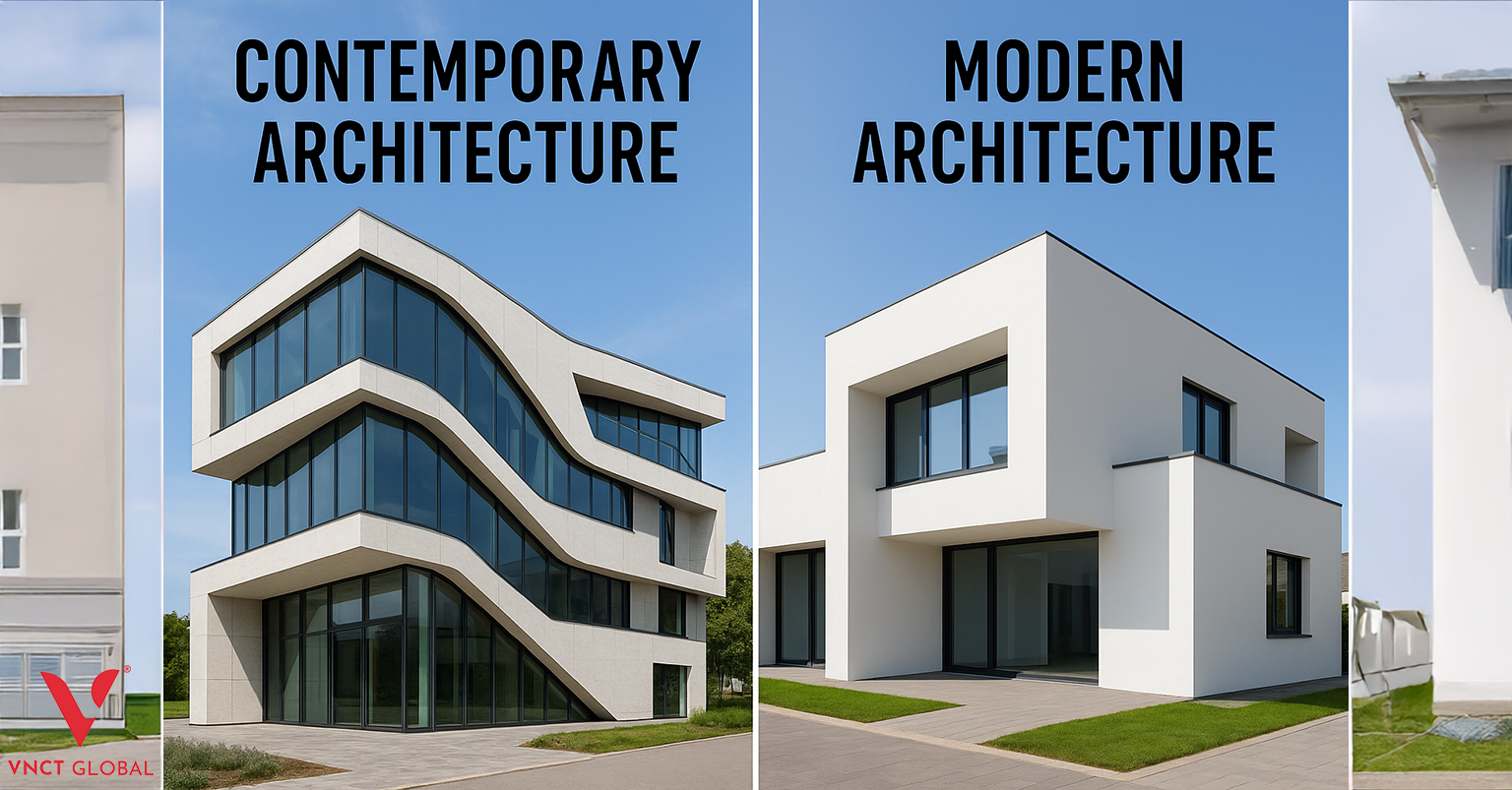Introduction
When you’re considering architectural style for a luxury home, particularly in the context of contemporary architecture vs modern architecture, the difference can feel subtle yet significant. Whether you’re investing in villas in Chennai, villas in Coimbatore or villas in Madurai with one of the best villa developers in India, or looking at a premium project by VNCT Global (from Brookside Residences, Palm Beach, Creek Residences, Park Villas to Ocean Drive Villas), understanding these styles helps you clarify your vision and align it with value, longevity and market appeal. For NRIs especially, who may be investing from abroad, knowing how architecture influences resale, maintenance and lifestyle is crucial. In this post we unpack the two styles, their relevance in 2026, how to choose between them, and how VNCT Global supports NRI-clients with design clarity and execution.
Contemporary Architecture: The Modern Luxury Statement
In simple terms, contemporary architecture refers to architecture of the moment the style that is relevant today and evolving.Contemporary homes often incorporate curves or unconventional forms, mixed materials, large glass expanses, sustainability features, smart home integration. K. Hovnanian Homes For investors and NRIs, a contemporary design in a luxury villa (especially a project by one of the largest villa developers in India) offers freshness, adaptability and strong appeal in the resale market. VNCT Global’s premium villas have increasingly adopted contemporary elements—open facades, floor-to-ceiling windows, and smart amenities giving NRI buyers a modern luxury lifestyle even while abroad.
Traditional Architecture: Timeless Elegance and Heritage
While “traditional” isn’t precisely one of the pair in the keyword, it’s helpful to contrast architecture rooted in earlier eras or regional vernacular with modern or contemporary. Traditional architecture in India might draw on classical elements, courtyards, pitched roofs, ornamental detailing, regional materials. For villas in Chennai or Madurai, this style resonates with heritage and contextual warmth. Choosing a more traditional style can appeal to a certain buyer segment and can blend well with local climate and culture—especially if you’re partnering with a reputed builder who understands regional contexts (like VNCT Global).
Regional Traditional Styles in India
In choosing your architecture, regionality matters:
- In Chennai/ECR, coastal influences, verandahs, cross-ventilation matter.
- In Madurai, traditional terracotta roofs or local stone could be used.
- In Coimbatore, a blend of hill-station style and modern luxury is possible.
When a builder claims to be one of the best villa developers in India, you’d expect them to integrate regional traditional styles with luxury execution and ensure that NRI clients understand climate, culture and maintenance demands.
Fusion Architecture: Trends of 2025–26
2025–26 sees a growing trend of fusion architecture: combining contemporary flair with traditional cues. In the question of contemporary architecture vs modern architecture, you’ll increasingly see blends a modernist minimal structure adorned with regional materials; a villa with clean lines (modern) but using local stone and pitched roof (traditional). This hybrid suits NRI buyers who want global aesthetics and local soul. A builder like VNCT Global catering to international-looking villas for NRIs taps into this. The result: homes that are “future-ready” yet rooted, balancing the best of both worlds befitting projects by the largest villa developers in India.
How to Choose Between Contemporary and Traditional Architecture for Luxury Homes
1. Lifestyle & personal taste – Do you prefer ultra-modern, open plan interiors, large glass walls, minimal ornament? Then contemporary or modern leanings. If you appreciate classic forms, warm materials, regional touches then traditional or fusion.
2. Maintenance and climate – For villas in Chennai or coastal zones, glass-heavy contemporary facades require good maintenance, may face heat or glare issues. Traditional stone or verandahs might be lower maintenance. For NRIs especially, you’ll want a design that works when you’re not onsite.
3. Resale & market trends – Contemporary architecture often fetches strong appeal among younger buyers and global investors; traditional can appeal to heritage-seeking segment. Partnering with one of the best villa developers in India ensures your design stays relevant.
4. Builder capability – If your developer (such as VNCT Global) has experience in both styles and supports NRI buyers via remote approvals, finishing options, you gain comfort. Ask: how many contemporary villas have they delivered? What’s their traditional portfolio?
5. Budget and value – Contemporary architecture may involve larger glass areas, premium materials, smart-home integration, which raises cost. Traditional materials may be cheaper but sometimes labour-intensive. Evaluate total cost of ownership.
6. Future proofing & trends – In 2026, sustainability and flexibility are key. A contemporary architecture mindset often includes eco-friendly materials, smart systems, adaptability. This matters especially if you’re investing through structures that claim “largest villa developers in India”.
Vastu Compliance Across Architectural Styles
For many Indian buyers including NRIs Vastu or similar regional guidelines influence design. Whether your villa leans contemporary architecture vs modern architecture, ensure that the builder integrates Vastu considerations: orientation, room placement, energy flow. With developers like VNCT Global, you’ll want confirmation they incorporate Vastu even in ultra-modern villa layouts so that style does not compromise established cultural/functional requirements.
Sustainability and Eco-friendliness in Architecture
A key driver in contemporary architecture vs modern architecture is sustainability. Modern architecture (20th century) emphasised new materials and function. Meanwhile, contemporary architecture (21st century) strongly emphasises eco-friendly construction methods, energy efficiency, and occupant-wellbeing. For NRIs investing in premium villas in Chennai, Coimbatore or Madurai, this means checking whether your builder uses sustainable materials, smart home systems, efficient glazing, and low-maintenance finishes. A builder that markets as one of the largest villa developers in India should have these systems well integrated.
Trends Shaping Architectural Choices in 2025
- Blurred indoors/outdoors: large sliding glass walls, outdoor living zones.
- Use of mixed materials: steel, glass, wood, local stone.
- Smart home integration co-designed with architecture.
- Sustainability: passive design, solar, rain-water harvesting.
- Personalisation: NRIs expect customised layouts and finishes.
In the question of contemporary architecture vs modern architecture, trends show a leaning to contemporary (flexible, adaptive) but rooted in modernist principles (clean lines, minimalism). Partnering with VNCT Global allows access to villas that reflect these trends without compromising build quality or resale appeal.
Your Final Decision: Contemporary or Traditional?
Ultimately, your choice between contemporary architecture vs modern architecture (and by extension traditional styles) should align with: your personal taste, long-term vision for the home, maintenance considerations (especially as an NRI), and market appeal. If you invest with a developer known among the best villa developers in India, or one of the largest villa developers in India, you gain access to experienced design teams, remote coordination, high-quality execution and that makes the decision less risky. Whether you choose a cutting-edge contemporary villa or a timeless traditional home, the right partner is key. When you’re ready to discuss design options, project location, remote approvals or finishes, contact us VNCT Global and let us guide you through the architectural style that fits you best.
FAQs for contemporary architecture vs modern architecture
- Is contemporary architecture the same as modern architecture?
No. Modern architecture refers to a defined movement (mostly 20th century: minimalism, steel/glass, functionalism). Contemporary architecture is broader and refers to the architecture of today fluid, adaptive, often combining multiple influences - Can a villa look both modern and contemporary?
Yes—it’s common to see a design that has modernist roots (simple geometry, minimalism) combined with contemporary elements (mixed materials, curves, sustainability). Many luxury villas built by top developers do exactly this. - For an NRI investing in India, which style is better?
Neither is inherently better. The key is alignment with your lifestyle, maintenance ability, market appeal and investment horizon. Choose a style your builder executes well, that fits your usage (holiday home vs rental vs resale). - Do contemporary homes cost more than modern or traditional ones?
They can. Since contemporary styles often use premium materials, smart technologies, custom forms, they may incur higher build cost and maintenance. Evaluate long-term value, especially for resale. - Will modern architecture look dated in future?
Possibly. Because modern architecture is tied to a past era, it may feel “classic mid-20th century” rather than forward-looking. Contemporary architecture, by definition, evolves and may remain fresher but tastes still change. - How does a luxury developer like VNCT Global help with architectural style decisions?
They bring: design expertise, portfolios of both modern/contemporary homes, finish & maintenance support (especially useful for NRIs), and ensure your villa whether you choose contemporary architecture vs modern architecture is built with high standards, premium materials and resale appeal.





